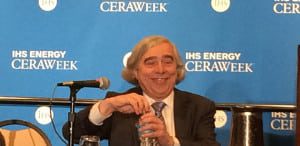DOE Secretary Moniz on WIPP and Spent Nuclear Fuel Storage
Department of Energy (DOE) Secretary Ernest Moniz reaffirmed that the Waste Isolation Pilot Plant (WIPP) in Carlsbad, N.M., is on track for reopening later this year, but he did not offer any encouragement to those in the southwest corner of the state who support using the site for permanent disposal of the country’s spent nuclear fuel (SNF) from civilian power reactors.
Shipments of waste from U.S. nuclear weapons sites were halted after two incidents in February 2014 raised health and safety concerns. On February 19, the DOE issued a preliminary notice of violation to the site operator, as well as to Los Alamos National Security, LLC, which operates Los Alamos National Lab (LANL) for the DOE, for health and safety violations related to two February 2014 events: “The first event involved a fire in a salt haul truck in the WIPP underground, and the second event involved a radiological release.”
Moniz made his comments on WIPP in response to a question from POWER at an IHS CERAWeek press briefing on February 24, asking what the prospects are for WIPP or a similar site being used for future long-term SNF storage. He noted that WIPP, developed in a deep saline formation, was designated as a repository for defense-related high-level waste (transuranic waste). Expanding WIPP’s scope would require congressional action.

Despite the operational problems at WIPP, the appropriateness of saline formations for long-term disposal of radioactive wastes has not been technically disputed.
In fact, former chairman of the U.S. Nuclear Regulatory Commission, Allison M. Macfarlane, had been a supporter of expanding the scope of WIPP to house SNF from the nation’s nuclear power plants.
In early February 2014, after the truck fire at WIPP, but before an improperly packaged waste container from LANL exploded underground, a New York Times article quoted Macfarlane as saying, “The main lesson from WIPP is that we have already developed a geologic repository for nuclear waste in this country, so we can in the future.”
Moniz noted at CERAWeek that there’s no talk of a “specific site” for SNF disposal. The DOE has just started the consent-based process of identifying states and communities that might be interested in hosting a site for “storage and/or disposal” of SNF, and the department has, he said, requested funds in fiscal year 2017 for the next phase, which would offer financial support “for communities that are seriously interested in pursuing the idea.”
As of this month, Carlsbad remains interested in providing an interim storage facility.
—Gail Reitenbach, PhD, editor (@GailReit, @POWERmagazine)